Home > Michigan > Michigan Crops & Livestock > The Rise of the Dairy in Michigan
The Rise of the Dairy in Michigan
In partnership with: Michigan Department of Agriculture & Rural Development
 Milk flows freely in Michigan, and the numbers speak for themselves. Since 2000, Michigan dairy farmers have increased milk production by 68 percent with just 30 percent more cows. “When I take a look at that data, that’s just proof to me that my perception of the Michigan dairy industry is true,” says Ken Nobis, a Clinton County dairy farmer and president of the Michigan Milk Producers Association. “You can’t have those kinds of increases unless you are doing a lot of things correctly.”
Milk flows freely in Michigan, and the numbers speak for themselves. Since 2000, Michigan dairy farmers have increased milk production by 68 percent with just 30 percent more cows. “When I take a look at that data, that’s just proof to me that my perception of the Michigan dairy industry is true,” says Ken Nobis, a Clinton County dairy farmer and president of the Michigan Milk Producers Association. “You can’t have those kinds of increases unless you are doing a lot of things correctly.” ![Michigan dairy [INFOGRAPHIC]](https://eadn-wc01-4177395.nxedge.io/wp-content/uploads/2020/05/Screen-Shot-2016-04-12-at-3.42.22-PM-740x442.jpg)
Dairy Climb
In 2015, Michigan started moving up in the ranks to become the sixth largest milk production state in the nation. State farmers in 2014 produced more than 9.6 billion pounds of milk, or in excess of 1.1 billion gallons. Growth continued into 2015 with a 7.2 percent increase mid-year alone, according to the U.S. Department of Agriculture Milk Production Report.
![Michigan dairy [INFOGRAPHIC]](https://eadn-wc01-4177395.nxedge.io/wp-content/uploads/2020/05/Screen-Shot-2016-04-12-at-3.49.57-PM.jpg) “We’ve seen a tremendous amount of growth in Michigan’s milk supply,” Cooper says. “Michigan has been growing at a rate of about seven percent for the last five years. If you ask me to look into my crystal ball, I think the upper Midwest is going to continue to grow at a rate dependent on plant capacity.”
“We’ve seen a tremendous amount of growth in Michigan’s milk supply,” Cooper says. “Michigan has been growing at a rate of about seven percent for the last five years. If you ask me to look into my crystal ball, I think the upper Midwest is going to continue to grow at a rate dependent on plant capacity.”
Managing Milk’s Growth
Michigan possesses the assets to encourage growth in milk production: a reasonable regulatory environment, proximity to large populations, access to feed and the benefit of family farms with generations of experience. Kevin and Reggie Newland run such a farm in Belding. Kevin is the third generation to operate Newland Farms, which milks about 400 cows twice daily. Reggie, too, is from a dairy family. Her father is a member of the board of the Dairy Farmers of America. “It’s a great way to raise a family,” Reggie says. “Our kids are learning the value of hard work and what it means to produce a product consumed by our family, friends and neighbors.”
![Michigan dairy [INFOGRAPHIC]](https://eadn-wc01-4177395.nxedge.io/wp-content/uploads/2020/05/Screen-Shot-2016-04-12-at-3.50.09-PM.jpg) Dairy represents the top-ranking segment of the state’s food and agriculture industry, contributing around 20 percent of Michigan’s cash receipts. The dairy industry generates an economic impact of $14.7 billion in the state, Nobis says. In Coopersville, fairlife® is among five new or expanded dairy facilities that got up and running between 2011 and 2014, according to MDARD. Operating in a former General Motors plant, fairlife® has been creating nutrient-rich ultra- filtered milk products using 1.5 million pounds of milk each day from local member farms since late 2013. “Michigan has been a terrific state to do business in,” says Anders Porter, director of communications for fairlife®. “There is a very progressive approach to attract and bring new businesses to the state.”
Dairy represents the top-ranking segment of the state’s food and agriculture industry, contributing around 20 percent of Michigan’s cash receipts. The dairy industry generates an economic impact of $14.7 billion in the state, Nobis says. In Coopersville, fairlife® is among five new or expanded dairy facilities that got up and running between 2011 and 2014, according to MDARD. Operating in a former General Motors plant, fairlife® has been creating nutrient-rich ultra- filtered milk products using 1.5 million pounds of milk each day from local member farms since late 2013. “Michigan has been a terrific state to do business in,” says Anders Porter, director of communications for fairlife®. “There is a very progressive approach to attract and bring new businesses to the state.”



